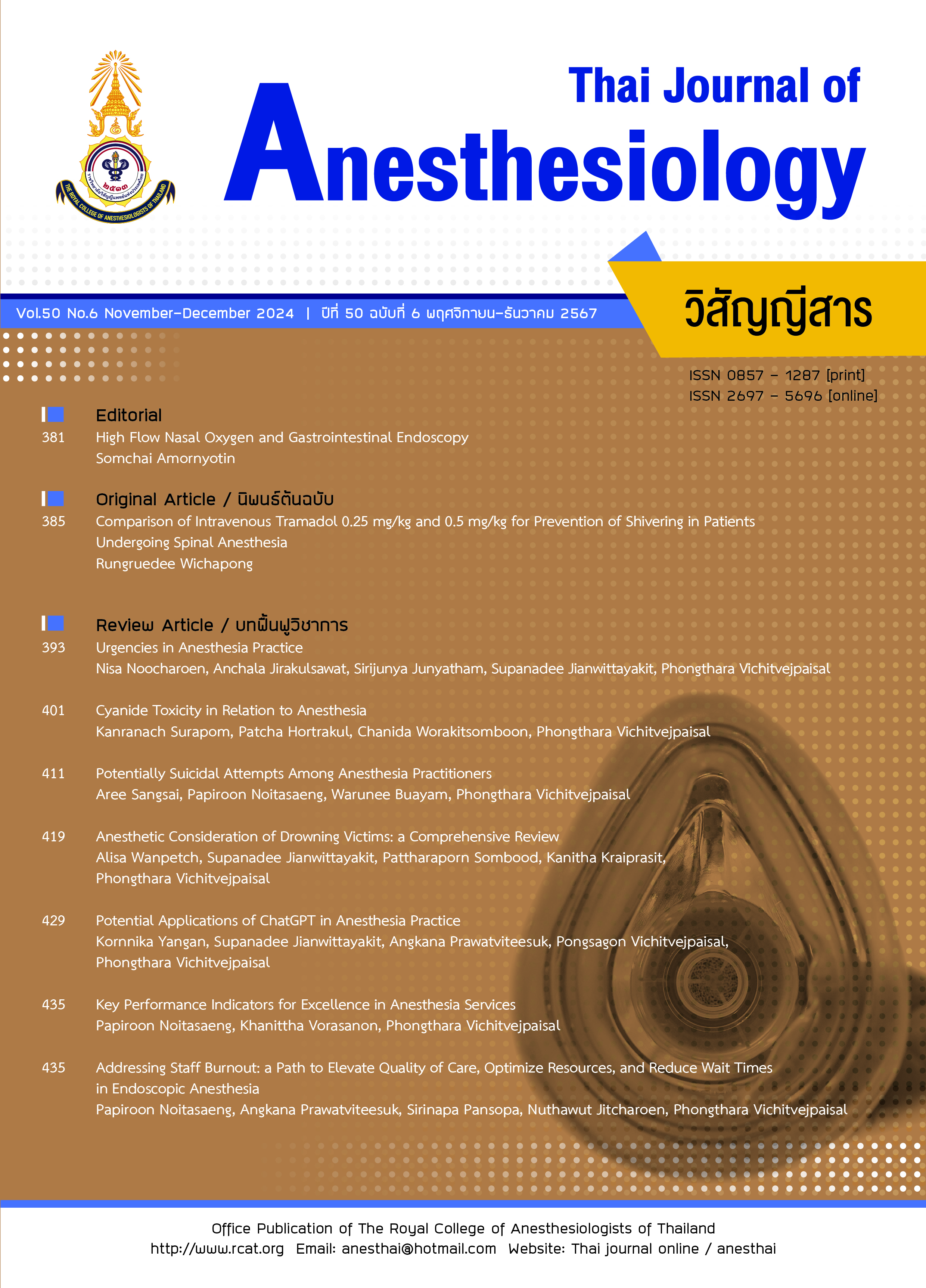Cyanide Toxicity in Relation to Anesthesia
Main Article Content
Abstract
Cyanide toxicity is a rare but potentially life-threatening complication associated with anesthesia. It disrupts cellular respiration by inhibiting cytochrome oxidase, which is crucial for the utilization of oxygen. This disruption ultimately leads to impaired oxygen consumption and tissue hypoxia. Anesthesia-related cyanide toxicity can occur through various mechanisms, including the metabolism of certain drugs or the inhalation of volatile agents. Its clinical presentation can be nonspecific and may include altered mental status, cardiovascular instability, and metabolic acidosis. Diagnosis can be aided by laboratory tests such as arterial blood gas analysis and serum lactate levels. Treatment of cyanide toxicity involves a multi-pronged approach that includes the administration of specific antidotes like hydroxocobalamin or sodium thiosulfate, as well as supportive measures to maintain oxygenation and hemodynamic stability. Additionally, the offending agent should be removed or discontinued.
Article Details

This work is licensed under a Creative Commons Attribution-NonCommercial-NoDerivatives 4.0 International License.
References
World Health Organization. Natural toxins in food. 2023 [cited 2023 May 28]. Available from: https://www.who.int/news-room/fact-sheets/detail/natural-toxins-in-food
Andama M, Oloya B. Effectiveness of traditional processing techniques in reducing cyanide levels in selected cassava varieties in Zombo District, Uganda. Int J Food Sci Biotechnol. 2017;2:121-5.
Marks J. Is Amygdalin a safe cancer treatment? 2021 [cited 2023 May 28]. Available from: https://www.webmd.com/cancer/amygdalin-cancer-treatment
Bizzaro G. The effects of the addition of additional succinate on mitochondrial respiration. 2010 [cited 2023 May 28]. Available from: https://www.studocu.com/en-us/document/university-of-south-florida/cellular-processes-laboratory/cellular-respiration-abstract/12771455
Cope RB. Cyanide poisoning in animals. Professional Vision. 2021 [cited 2023 May 30]. Available from: https://www.msdvetmanual.com/toxicology/cyanide-poisoning/cyanide-poisoning-in-animals#top
Isolation and purification of 3-Mercaptopyruvate sulfurtransferase from the gut of rhinoceros larva (Oryctes rhinoceros). Research wap. 2023 [Cited 2023 May 25]. Available from: https://researchwap.net/biochemistry/prUbgJKjxA7nox#
Isom GE, Borowitz JL, Mukhopadhyay S. Sulfurtransferase enzymes involved in cyanide metabolism, Comprehensive Toxicology, Second Ed, McQueen CA, ed, Elsevier, Oxford, 2010;4:485-500.
Mohd Azmi Ahmad F. Cyanogenic glycosides in cassava [Thesis/Doctor of Philosophy]. The University of Leeds School of Food Science and Nutrition; 2019.
Byrd BL, Asuka E, Martin N. Antidotes. StatPearls. 2023 [cited 2023 June 20]. Available from: https://www.ncbi.nlm.nih.gov/books/NBK539884/
Hydrogen cyanide. Emergency department/Hospital management. 2023 [cited 2023 June 20]. Available from: https://chemm.hhs.gov/cyanide_hospital_mmg.htm
Hall HA, Rumack HB. Clinical toxicology of cyanide. Ann Emerg Med. 1986;15:1067-74.
Lagow B. eds. Lab test: Cyanide (blood) level. a comprehensive point of care guide for over 600 lab tests. 2007 [cited 2023 June 3]. Available from: https://www.ebmconsult.com/articles/lab-test-cyanide-level#jump_ss_102504
Holme MR, Sharman T. Sodium Nitroprusside. [Updated 2023 May 22]. In: StatPearls. Treasure Island (FL): StatPearls Publishing; 2024 Jan-. Available from: https://www.ncbi.nlm.nih.gov/books/NBK557487/
Chung KH, Park SM, Baek IC, Jang J, Hong YW, Ahn S. Cyanide toxicity during cardiopulmonary bypass with small dose of nitroprusside: a case report. Korean J Anesthesiol. 2016;69:181-4.
Cyanocobalamin. Wikipedia. [cited 2023 March 30]. Available from: https://en.wikipedia.org/wiki/Cyanocobalamin#
Lee J, Keuter KA, Kim J, et al. Noninvasive in vivo monitoring of cyanide toxicity and treatment using diffuse optical spectroscopy in a rabbit model. Mil Med. 2009;174:615-21.
Nguyen Y, Bora V. Arterial pressure monitoring. StatPearls. 2023 [cited 2023 March 19]. Available from: https://www.ncbi.nlm.nih.gov/books/NBK556127/
Karagiannis MH, Reniker A, Kerl M, Mann FA. Lactate measurement as an indicator of perfusion. Compendium. 2006 [cited 2023 March 30]: Available from: https://www.vetfolio.com/learn/article/lactate-measurement-as-an-indicator-of-perfusion
Castro D, Patil MS, Keenaghan M. Arterial blood gas. StatPearls. 2022 [cited 2023 March 15]. Available from: https://www.ncbi.nlm.nih.gov/books/NBK536919/
Graham J, Traylor J. Cyanide toxicity. StatPearls. 2023 [cited 2023 Febuary 13]. Available from: https://www.ncbi.nlm.nih.gov/books/NBK507796/
Evans J, Pandya A, Ding Y, Qunibi WY. Hydroxocobalamin induced oxalate nephropathy in a patient with smoke inhalation. Kidney Int Rep. 2021;6:2228-31.
Hydroxocobalamin (Rx). Medscape. Available from: [cited 2023 June 12] https://reference.medscape.com/drug/cyanokit-hydroxocobalamin-343734
Cyanokit (hydroxocobalamin for injection) for intravenous infusion. [cited 2023 June 12]. Available from: https://www.accessdata.fda.gov/drugsatfda_docs/label/2018/022041s019,%20020lbl.pdf.
Thiosulfuric acid. Drugbank online. [cited 2023 May 28]. Available from: https://go.drugbank.com/drugs/DB09499.
Spicuzza L, Schisano M. High-flow nasal cannula oxygen therapy as an emerging option for respiratory failure: the present and the future. Ther Adv Chronic Dis. 2020;11:2040622320920106.
Jung B, Martinez M, Claessens YE, et al. Diagnosis and management of metabolic acidosis: guidelines from a French expert panel. Ann Intensive Care. 2019;9:92.
Nessim SJ, Richardson RMA. Dialysis for thiocyanate intoxication: a case report and review of the literature. ASAIO J. 2006;52:479-81.
Li M, Xin S, Gu R, et al. Novel diagnostic biomarkers related to oxidative stress and macrophage ferroptosis in atherosclerosis. Oxid Med Cell Longev. 2022;2022:8917947.
Deng C, Liu J, Zhang W. Structural modification in anesthetic drug development for prodrugs and soft drugs. Front Pharmacol. 2022;13:923353.
Berkenstadt H, Ziv A, Barsuk D, Levine I, Cohen A, Vardi A. The use of advanced simulation in the training of Anesthesiologists to treat chemical warfare casualties. Anesth Analg. 2003;96:1739-42.

